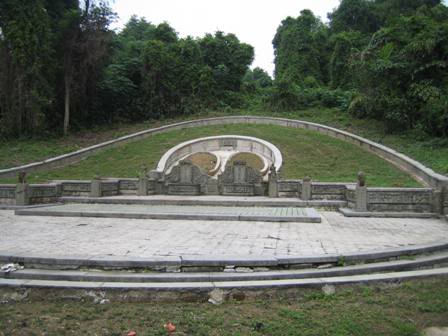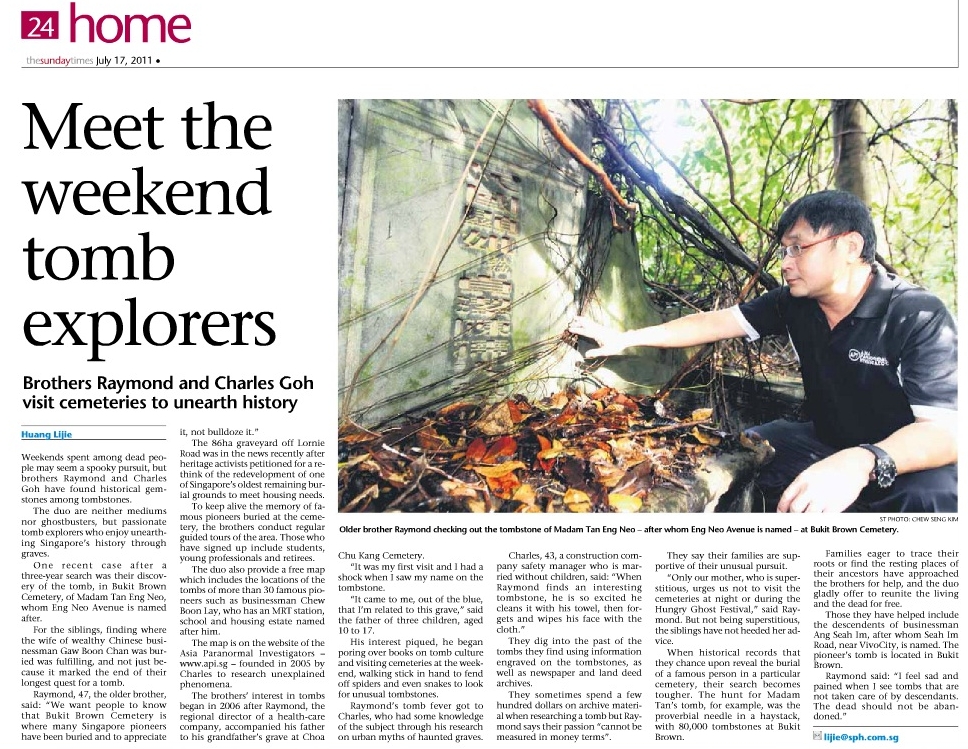The Biggest Grave in Singapore

Do you know where is the biggest grave in Singapore?
The size of 10 3 roomed HDB flats, this grave was ‘discovered‘ in June 2006, and ‘rediscovered by API in 2007. Now the Tomb, which lies in Bukit Brown cemetery, is 1 of the destinations in many of API Spooky tours.
The Biggest Tomb has been featured in many API media news (1, 2, 3) and on Channel U – ON THE BEAT 2 as well.
Watch the Trailer here.
Meet the Weekend Tomb Explorers

Weekends spent among dead people may seem a spooky pursuit, but brothers Raymond and Charles Goh have found historical gemstones among tombstones.
The duo are neither mediums nor ghostbusters, but passionate tomb explorers who enjoy unearthing Singapore’s history through graves.
One recent case after a three-year search was their discovery of the tomb, in Bukit Brown Cemetery, of Madam Tan Eng Neo, whom Eng Neo Avenue is named after.
For the siblings, finding where the wife of wealthy Chinese businessman Gaw Boon Chan was buried was fulfilling, and not just because it marked the end of their longest quest for a tomb.
Raymond, 47, the older brother, said: ‘We want people to know that Bukit Brown Cemetery is where many Singapore pioneers have been buried and to appreciate it, not bulldoze it.’
The 86ha graveyard off Lornie Road was in the news recently after heritage activists petitioned for a rethink of the redevelopment of one of Singapore’s oldest remaining burial grounds to meet housing needs.
To keep alive the memory of famous pioneers buried at the cemetery, the brothers conduct regular guided tours of the area. Those who have signed up include students, young professionals and retirees.
The duo also provide a free map which includes the locations of the tombs of more than 30 famous pioneers such as businessman Chew Boon Lay, who has an MRT station, school and housing estate named after him.
The map is on the website of the Asia Paranormal Investigators – http://www.api.sg – founded in 2005 by Charles to research unexplained phenomena.
The brothers’ interest in tombs began in 2006 after Raymond, the regional director of a health-care company, accompanied his father to his grandfather’s grave at Choa Chu Kang Cemetery.
‘It was my first visit and I had a shock when I saw my name on the tombstone.
‘It came to me, out of the blue, that I’m related to this grave,’ said the father of three children, aged 10 to 17.
His interest piqued, he began poring over books on tomb culture and visiting cemeteries at the weekend, walking stick in hand to fend off spiders and even snakes to look for unusual tombstones.
Raymond’s tomb fever got to Charles, who had some knowledge of the subject through his research on urban myths of haunted graves.
Charles, 43, a construction company safety manager who is married without children, said: ‘When Raymond finds an interesting tombstone, he is so excited he cleans it with his towel, then forgets and wipes his face with the cloth.’
They dig into the past of the tombs they find using information engraved on the tombstones, as well as newspaper and land deed archives.
They sometimes spend a few hundred dollars on archive material when researching a tomb but Raymond says their passion ‘cannot be measured in money terms’.
They say their families are supportive of their unusual pursuit.
‘Only our mother, who is superstitious, urges us not to visit the cemeteries at night or during the Hungry Ghost Festival,’ said Raymond. But not being superstitious, the siblings have not heeded her advice.
When historical records that they chance upon reveal the burial of a famous person in a particular cemetery, their search becomes tougher. The hunt for Madam Tan’s tomb, for example, was the proverbial needle in a haystack, with 80,000 tombstones at Bukit Brown.
Families eager to trace their roots or find the resting places of their ancestors have approached the brothers for help, and the duo gladly offer to reunite the living and the dead for free.
Those they have helped include the descendents of businessman Ang Seah Im, after whom Seah Im Road, near VivoCity, is named. The pioneer’s tomb is located in Bukit Brown.
Raymond said: ‘I feel sad and pained when I see tombs that are not taken care of by descendants. The dead should not be abandoned.’
Buried: A Life
The graveyards are coming ‘alive’ again and it is not just due to the ongoing annual Qing Ming Festival, when many go to pay their respects to the departed.
A lively interest has sprung up in Singapore graveyards and their history, so much so that two brothers offer day and night cemetery tours based on request.
An average of 40 people a time happily shell out up to $45 each to be escorted by amateur historians Charles and Raymond Goh. The groups are a mix of young working professionals and the elderly.
However, the brothers stress that their cemetery sightseeing is not so much a quest for the dead but for living history.
In Bukit Brown Cemetery, Charles Goh (above) points to an area filled with offerings such as crabs, sweets and biscuits, which were probably left behind by punters asking the spirits for 4D numbers.
Besides conducting the tours, the history buffs, who are licensed tour guides, also explore graveyards, some abandoned, in areas such as Choa Chu Kang, Bukit Timah Hill and MacRitchie Reservoir, on their own.
Even government agencies such as the National Heritage Board and the Central Narcotics Bureau have taken notice of their tours and organised such outings for their employees.
Teacher Martina Ong, 36, who has taken her secondary school class on the tour twice, says her students found the experience enriching.
‘It was rather informative as they presented it from the point of view of history and culture, rather than focusing on the spooky bit,’ says Mrs Ong.
The tours are conducted under the banner of Asia Paranormal Investigators (API), which conducts research into unexplained phenomena. The brothers founded it in 2005 and have become a familiar sight amid the tombs with their distinctive black Asia Paranormal Investigators T-shirts.
Finding the dead is no easy task. Raymond, 48, a pharmacist, often encounters difficult terrain and has to bring a walking stick to clear the path of spider webs.
He says: ‘I try to map out the area and bring a notebook to write down any unusual graves. The tombkeepers used to wonder why I kept coming back, but now that they know my reasons, they will try and help me.’
Based on the information engraved on tombstones, the brothers do research online, in the newspapers and at the National Archives in an attempt to unearth the history behind them.
Two weeks ago, they discovered the grave of businessman Ang Seah Im, for whom Seah Im Road is named, in the 80ha Bukit Brown Cemetery.
‘It is always a pleasure to find familiar names. Bukit Brown is like a living museum. You get to stand in front of the pioneers and learn about history,’ says safety supervisor Charles, 43.
Charles says the brothers hope to put the knowledge they have accumulated into a book someday. As it is, they often receive calls from members of the public asking for help in tracking down the lost graves of relatives.
The brothers estimate that they have explored only about 10 per cent of the 80,000 tombstones in Bukit Brown. Some are crumbling and overgrown, while others have undergone a recent ‘renovation’, thanks to Qing Ming.
The cemetery is also where the tomb of Hokkien businessman Cheng Hong Lim (above), who created Hong Lim Park, is located. — ST PHOTOS: NEO XIAOBIN
They include the graves of 19th-century tycoon Ong Sam Leong and his wife, which occupy an area equivalent to 10 three-bedroom flats. Statues of lions, chambermaids and 2m-tall Sikh guards stand watch over the remains, which were rediscovered in 2006.
But little-known cemeteries such as the Japanese Cemetery Park also hold intriguing historical facts.
Nestled in a quiet corner of a private housing estate in Hougang, it was initially earmarked as a burial ground for what were known as karayuki-san (literally, Miss Gone Overseas) – young Japanese women who were sold in the 19th century and brought to Singapore as prostitutes.
During World War II, the remains of Japanese soldiers and civilians were also interred there.
Charles notes: ‘Things are constantly being torn down and built up in Singapore but one of the places that remains is graveyards.
‘They are like hidden gems, with stories waiting to be told.’
nicy@sph.com.sg
——————————————————————————–
Grave tours
BUKIT BROWN CEMETERY (LORNIE ROAD)
Bukit Brown holds the remains of many Singapore pioneers including Chew Boon Lay, Lim Chong Pang and Lim Nee Soon, as well as Tan Kim Ching, eldest son of Tan Tock Seng.
It also includes what may be the oldest grave in Singapore – the final resting place of a certain Fang Shan, who died in 1833.
CHUA CHU KANG CHINESE CEMETERY
Many graves here are built in the shape of animals such as fish or snakes, in accordance with fengshui principles.
In the night, it also attracts many mediums and their followers, who conduct regular seances there.
JAPANESE CEMETERY PARK (CHUAN HOE AVENUE)
The land was donated by brothel owner Tagajiro Fukaki in the 19th century as a burial ground for Japanese prostitutes and is now maintained by the Japanese Association of Singapore. No one has been buried there since 1973.
Famous names interred there include field marshal Count Terauchi Hisaichi, supreme commander of Japanese forces in South-east Asia during WWII.
The graves of the Japanese prostitutes, their children and their mama-sans range from simple grave markers to elaborate tombstones.
To book a tour with Asia Paranormal Investigators, e-mail events@api.sg or call 9878-8669. The cost of a tour ranges from $20 to $45 and includes transport.

